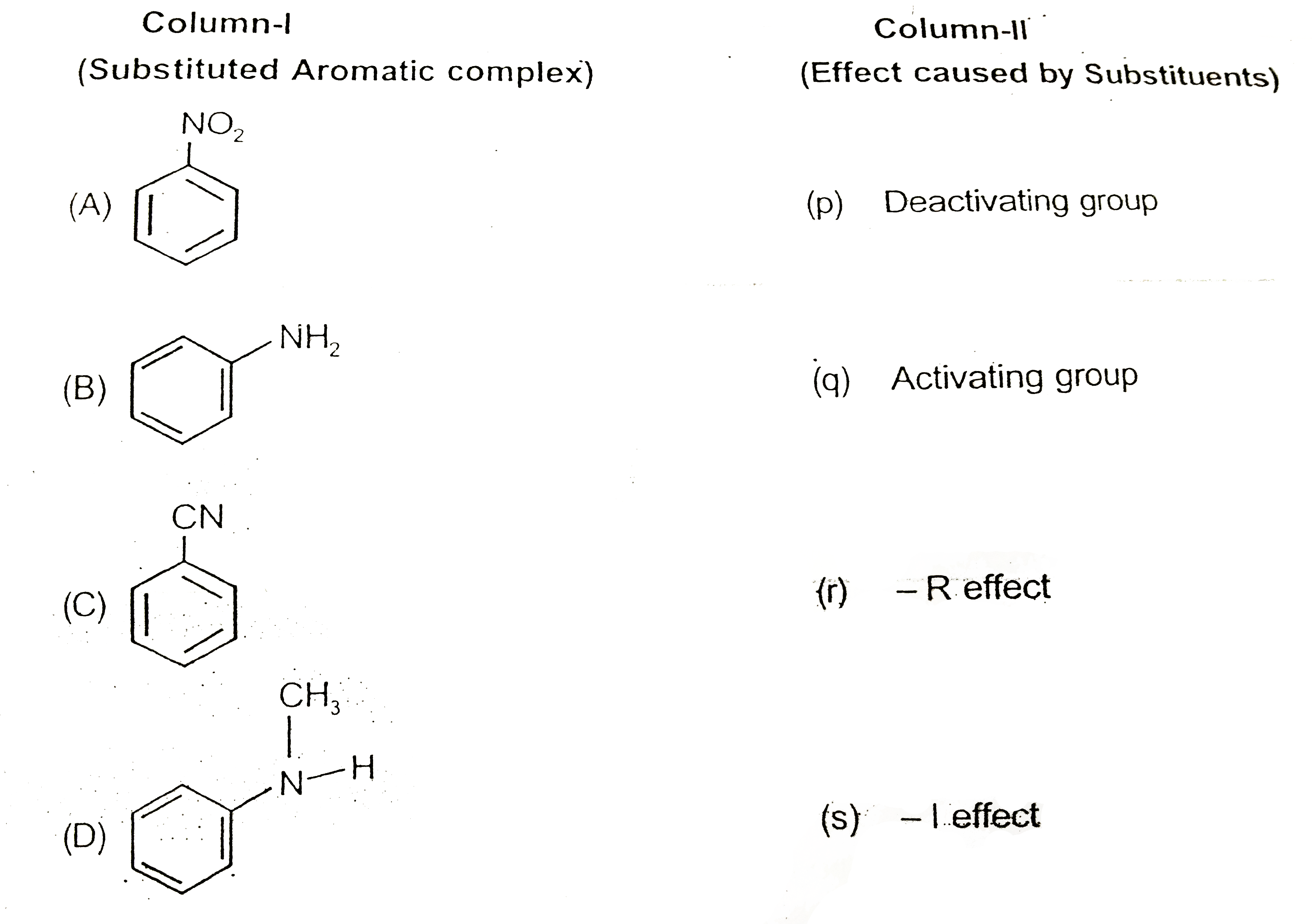Match the following.
a.Floating roots(Coloumn I) - (i)Podostemon(Coloumn II)
b. Assimilatory roots(Coloumn I) - (ii)Cuscuta (Coloumn II)
c. Hygroscopic roots(Coloumn I) - (iii)Bryophylum (Coloumn II)
d. Haustorial roots(Coloumn I) - (iv)Jussiaea (Coloumn II)
e. Epiphylous roots(Coloumn I) - (v)Orchids(Coloumn II)
a(iii), b(i), c(v), d(ii), e(iv)
a(ii), b(i), c(v), d(ii), e(iv)
a(iv), b(i), c(v), d(ii), e(iii)
a(i), b(ii), c(v), d(iii), e(iv)
The correct Answer is:C
To solve the matching question, we will analyze each type of root in Column I and find the corresponding example in Column II.
1. Floating Roots (Column I - a):
- Definition: Floating roots are roots that help the plant float and are negatively geotropic.
- Example: The plant Jussiaea is known for having floating roots.
- Match: a - (iv) Jussiaea
2. Assimilatory Roots (Column I - b):
- Definition: Assimilatory roots are capable of photosynthesis due to the presence of chlorophyll.
- Example: The plant Podostemon has assimilatory roots that perform photosynthesis.
- Match: b - (i) Podostemon
3. Hygroscopic Roots (Column I - c):
- Definition: Hygroscopic roots absorb moisture from the air.
- Example: Orchids are known for having hygroscopic roots that can absorb moisture.
- Match: c - (v) Orchids
4. Haustorial Roots (Column I - d):
- Definition: Haustorial roots are specialized roots that attach to a host plant, often found in parasitic plants.
- Example: Cuscuta is a parasitic plant that has haustorial roots.
- Match: d - (ii) Cuscuta
5. Epiphylous Roots (Column I - e):
- Definition: Epiphylous roots grow from the leaves and are often seen in certain plants.
- Example: Bryophyllum is known for having epiphylous roots.
- Match: e - (iii) Bryophyllum
Final Matches:
- a - (iv) Jussiaea
- b - (i) Podostemon
- c - (v) Orchids
- d - (ii) Cuscuta
- e - (iii) Bryophyllum
Summary of Matches:
- a → iv
- b → i
- c → v
- d → ii
- e → iii
- Definition: Floating roots are roots that help the plant float and are negatively geotropic.
- Example: The plant Jussiaea is known for having floating roots.
- Match: a - (iv) Jussiaea
- Definition: Assimilatory roots are capable of photosynthesis due to the presence of chlorophyll.
- Example: The plant Podostemon has assimilatory roots that perform photosynthesis.
- Match: b - (i) Podostemon
- Definition: Hygroscopic roots absorb moisture from the air.
- Example: Orchids are known for having hygroscopic roots that can absorb moisture.
- Match: c - (v) Orchids
- Definition: Haustorial roots are specialized roots that attach to a host plant, often found in parasitic plants.
- Example: Cuscuta is a parasitic plant that has haustorial roots.
- Match: d - (ii) Cuscuta
- Definition: Epiphylous roots grow from the leaves and are often seen in certain plants.
- Example: Bryophyllum is known for having epiphylous roots.
- Match: e - (iii) Bryophyllum
- a - (iv) Jussiaea
- b - (i) Podostemon
- c - (v) Orchids
- d - (ii) Cuscuta
- e - (iii) Bryophyllum
- a → iv
- b → i
- c → v
- d → ii
- e → iii
Topper's Solved these Questions
Similar Questions
Match the following.
a. Gametangial contact (Coloumn I) - (i) Agaricus(Coloumn II)
b. Planogametic copulation(Coloumn I) - (ii) Mucor(Coloumn II)
c. Somatogamy(Coloumn I) - (iii) Puccinia(Coloumn II)
d. Gametangial copulation (Coloumn I) - (iv) Allomyces (Coloumn II)
e. Spermatization (Coloumn I) - (v) Pythium (Coloumn II)
View SolutionMatch the coloumn I with coloumn II and select the correct option. a. Rhizome(Coloumn I) - (i) Lily(Coloumn II) b. Bulb(Coloumn I) - (ii) Gladiolus(Coloumn II) c. Sucker(Coloumn I) - (iii) Grass(Coloumn II) d. Corm(Coloumn I) - (iv) Curcuma(Coloumn II) e. Runner(Coloumn I) - (v) Banana(Coloumn II)
View SolutionMatch the following coloumn. a. Corticolous (Coloumn I) - (i) Fungi growing on cow dung (Coloumn II) b. Xylophilous (Coloumn I) - (ii) Fungi growing on wood (Coloumn II) c. Epixylic (Coloumn I) - (iii) Fungi growing on hair (Coloumn II) d. Keratinophilous (Coloumn I) - (iv) Fungi growing on burnt wood (Coloumn II) e. Coprophilous (Coloumn I) - (v) Fungi growing on bark (Coloumn II)
View SolutionMatch the following coloumns and select the correct option. a. Hibernation(Coloumn-I) - (i) Snails(Couloumn-II) b. Aestivation(Coloumn-I) - (ii) Many zooplanktons(Coloumn-II) c. Migration(Coloumn-I) - (iii) Polar bears(Coloumn-II) d. Diapause(Coloumn-I) - (iv) Siberian cranes(Coloumn-II)
View SolutionMatch the columns and choose the correct answer.
(a) Aldosterone (Column I) (i) Zona fasciculata (Column II) (b) DHEA (Column I) (ii) Zona glomerulosa (Column II) (c) Cortisol (Column I) (iii) Zona reticulans (Column II) (d) Adrenaline (Column I) (iv) Adrenal medulla (Column II)
View Solutionmatch the following column. a. Zygomycetes(Column I) b.Ascomycetes(Column I) c. Oomycetes(Column I) d. Basidiomycetes(Column I) e. Deuteromycetes(Column I). (i) Algal fungi(Column II) (ii) club fungi(Column II) (iii) Fungi imperfecti(Column II) (iv) Sac fungi(Column II) (v) conjugation fungi(Column II).
View SolutionMatch Column I with Column II. (a) Physalia (Column I),(i) Devil fish (Column II),(b) Ascaris (Column I),(ii) King crab (Column II),(c) Limulus (Column I),(iii) Roundworm (Column II),(d) Octopus (Column I),(iv) Portuguese man of war (Column II)
View Solutionmatch the following: a. ICNB (column I) and (i) bacteriophage (column II). (b) ICNCP(column I) and (ii) animals(column II). (c)ICVCN( column I) and (iii) Vibrio cholerae (column II). (d)ICZN(column I) and (iv) cultivated plants (column II)
View Solutionmatch the following column a. small pox (column I) b.German measles(column I) c.Mumps(column I) d.AIDS(column I) e. Polimyelitis (column I) . (i) paramyxo virus (column II) (ii) polio virus(column II) (iii) variola virus (column II) ( iv) Rubella virus(column II) (v) Retro virus(column II).
View SolutionMatch the coloumn-I with column-II

View Solution
